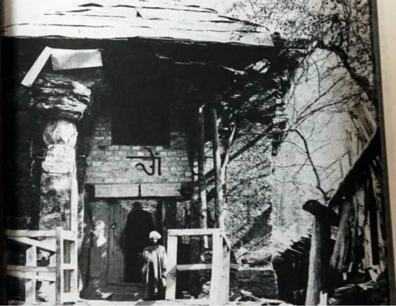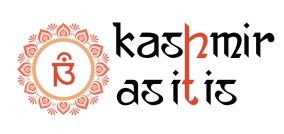Repository of Faith; Legend and Love
Upender Ambardar
Sarada Mata Temple, dedicated to the Goddess Sarada,  is located in Dhrov region of Pakistan occupied Kashmir. In spite of being out of bounds for the worshippers presently, the faith and allegiance to the temple has in no way lessened. The strong emotional bond associated with the temple which stretch back to the age-old times continue to remain alive even today. The temple represents the spiritual, religious and cultural soul of Kashmir as the Goddess Sharada is regarded as the presiding and governing deity of the entire Kashmir region.
is located in Dhrov region of Pakistan occupied Kashmir. In spite of being out of bounds for the worshippers presently, the faith and allegiance to the temple has in no way lessened. The strong emotional bond associated with the temple which stretch back to the age-old times continue to remain alive even today. The temple represents the spiritual, religious and cultural soul of Kashmir as the Goddess Sharada is regarded as the presiding and governing deity of the entire Kashmir region.
As the Goddess of speech, intellect and exalted thoughts, Sharda Mata is believed to be present wherever speech, communication and language exist. Goddess Sharda is also known by the name of Vaksavitri, the Creater of all kinds of communication, knowledge and wisdom, particularly the spiritual one.
Prior to 1947, the holy pilgrimage would usually start from the village Tikar (Kupwara district). The next stops were Batergham and Hiri villages. From Hiri, one could proceed either via Trehgam or through Liderwan. Liderwan, at a distance of about six kms. from Kupwara, used to be the base camp for the yatris coming from Baramulla, Sopore, Kupwara, Srinagar and other parts of Kashmir.
The arduous journey commencing from Liderwan had halting spots at Zurhome, Marhome (Marhama), Budan Pathar and Ganesh Pael. The area of Ganesh Pael was also known by the name of Bandook Pael by the native Gujjars. Ganesh Pael owed its name to the striking resemblance of a huge boulder to Lord Ganesh’s appearance.
The area of Ganesh Pael would also serve as the resting place for the pilgrims. Next to it was Pothkhagali, which was also used as halting place by those yatris, who would not prefer to make a stopover at Ganesh Pael. Pothkah Gali was followed by the destinations of Mirwali Naar, Dunaar (Dunari) and the villages of Jumgun and Katchban. The village of Kanthawali was the next stop, which was followed by small villages of Shawlbouth, Baensawali, Andher Bela and Dudhniyal. Dudhniyal had a narrow suspension footbridge. The pilgrims and travelers would unload their horses here as the narrow footbridge would not permit the loaded horses or horses with the riders to cross it. After taking the path along the bank of Kishanganga river, the travelers would reach the village of Bella Mohammed Khan, followed by Sheikh Bella and Mundkar villages.
Dusuth was the next village, followed by Khowaja Seeri and Kharigham villages. Kharigham was the nearest village on the route to Sharda temple. Till 1947, the village of Liderwan had a lone Kashmiri Pandit household of Late Sh. Thoker Pandit Thusoo. He along with his wife late Smt. Sokhded and their two sons Sh. Tika Lal Thusoo and Sh. Nand Lal Thusoo and their extended families would reside there. Both, Sh. Tika Lal and Sh. Nand Lal, jointly ran a grocer’s shop at Liderwan. They also owned a house and a shop at the village Shardi itself. Smt. Rekhmaal, wife of late Sh. Nand Lal Thusoo, Smt. Teezmaal, wife of Late Sh. Tika Lal Thusoo and Smt. Dhanwati, wife of Sh. Sona Lal Thusoo, the elder son of Late Sh. Tika Lal Thusoo, apart from doing their house hold chores would also manage the free community kitchen (langar) for the devotees proceeding on pilgrimage to the Sharda temple. They would prepare rotis, cook dry vegetables and pack them with pickles for the yatris. A free kitchen run by them at the village Dudhniyal would also provide meals to the pilgrims. They also owned water driven mills at Katchban and Shardi villages and had also constructed a dharmshala for the pilgrims at Dudhniyal.
A primary school built by them at Dudhniyal catered to the educational needs of Gujjar children residing there and in the adjoining areas of Dudhniyal. As such they were the pioneers in the introduction of primary education in this remote region. The Thusoo brothers would also make arrangements for horses and palanquins for old and infirm pilgrims.
According to Sh. Puranji Thusoo, the grandson of late Sh. Nand Lal Thusoo, a densely foliaged upland area in the close proximity of the Sharda temple was known by the name of Ganesh Ghatti. As divulged to him by his elders, it had a cave, the narrow opening of which would allow the entry of a single person at a time. The open space inside the cave was said to be big enough to accommodate about a dozen pilgrims. The inside of the cave, on one of its side resembled the image of Lord Ganesh, on which water drops would trickle down from a naturally formed Sheshnag like configuration located above. As per a local lore, a Kashmiri Pandit of religious disposition posted at Shardi village during Maharaja’s rule was once directed in a dream by Lord Ganesh to come to the said cave to have his darshan there. It resulted in the discovery of the cave and subsequent naming of the cave area as Ganesh Ghati. According to Sh. Puran Ji Thusoo, a hill side elevated area in close proximity of the Sharda Mata Temple was also known by the name of Amarnath. It was in the form of a massive boulder over which water from the adjoining mountain would flow down in a ‘havan-kund’ patterned natural enclosure below.

A rare picture of the Sharda Mata temple taken by Sir Aurel Stein in 1893
Smt. Arundati Dass, wife of Sh. Dina Nath Dass of Bomai (Sopore) is the daughter of Late Sh. Nand Lal Thusoo of Liderwan. Despite advanced age, she retains memories of her formative years spent at Liderwan and Shardi.
According to Smt. Arundati Dass, before Liderwan, the first major pilgrimage destination in the earlier times was the village of Jumagund. It is at a distance of 30 kms from Liderwan. She recollects that those on the horse backs would proceed on journey at the crack of dawn from Jumagund and would reach Dudhniyal in the afternoon. The horses were driven on the hilly track by their owners called ‘markbans’ locally. Jumagund village had then only a few scattered Gujjar dwellings. At Jumagund, most of the travelers would cook rice and vegetable preparations usually of ‘hak’ and potatoes in earthen pots (laej) on make-shift ovens in the open. Reminiscing further about those days, she said that life was simple and unostentatious, devoid of any competitiveness.
She further revealed that the turban in those days was a part of the identity and culture for Kashmiri Pandits. Kashmiri Pandit ladies in addition to sporting traditional ethnic dress of ‘Pheran’ and head dress of ‘Targa’ would also wear a veil (burka) over it while moving out of their homes. In contrast to the black colored veil worn by Muslim women, Pandit ladies would wear white colored ‘burka’. The burka clad Pandit women were referred to as ‘Setra Khatoon’.
Mrs. Arundati Dass said the peculiar ambience combined with spectacular picturesque surrounding around the temple would arouse spiritual ecstasy in all and sundry. The stone steps leading to the temple at the start were smaller in size. The staircase was called ‘Pandav Haer’ in their times.
According to her, on chiseled stone steps of ‘Panda Haer’, four to five devotees could climb up together at a time. Before entry into the temple, there stood a huge ‘Bren’ tree on the left side of the plain area. It had a stone idol of Lord Ganesh at its base, which was smeared with ‘sindoor’. Before making an entry into the temple, the devotees would perform puja of Lord Ganesh. The enclosure of the temple was spacious enough to accommodate two dozen devotees at a time. Smt. Arundati recounted that a huge ‘Shila’ about six feet long and about the same width and half a foot thick was the holy sanctum sanctorum of the temple. The ‘Shila’ was regarded as the manifestation of Goddess Sharda. It was in the middle of the inner enclosure of the temple. As per belief, a spring of divine nectar (amrit kund) existed underneath the holy ‘Shila’.
A streamlet, which flowed in the courtyard of the temple was believed to have its origin at the divine ‘Amrit Kund’. It was known by the name of Madhumati. A traditional belief says that the devotees could hear the sound of the underground water flow, if one would put his ears on the Shila surface. According to a native folklore, Goddess Sharda is believed to have taken shelter inside the divine spring beneath the sanctified ‘Shila’ after coming out from the nearby mountainous area of Narda on account of the displeasing and annoying pursuits of the demons there. Narda is a towering and giant mountain about 6-7 kms. away from Sharda Mata Temple. According to the same lore, Narda is regarded as the manifestation of the Goddess Sharda in the virgin form. Interestingly, Goddess Narda is one of the ‘Kul Devis’, of some of the Dogra Rainas of Jammu region. The temple lore believes that Goddess Sharda draped in the celestial attire and wearing divine gold and jewel ornaments resides in the ‘Amrit Kund’ underneath the holy ‘Shila’ of the temple. The same lore also says that the consecrated embellishments, accompaniments, divine garments and eating utensils like ‘thali’ of Sharda Mata are also sheltered in the sanctified spring of the Amrit Kund’.
As per a local legend, a Kashmiri Pandit lady belonging to Gulgam, Kupwara was an ardent believer of Goddess Sharda. Driven by acute poverty, she came all the way from Gulgam to Sharda Mata temple and reverentially prayed to the Goddess to be redeemed from the deprivations. Pleased with her devotion, a divine ‘thali’ is a believed to have emerged from the sacred spring underneath the holy ‘Shila’. It was believed to provide food whenever the said lady desired but, on the condition, that none other than her could make use of it. However, once the said lady is said to have utilized the divine thali to offer food to her brother. The divine thali is believed to have broken into pieces at that very moment and simultaneously the thali is said to have vanished from the sacred spring. Another Sharda temple lore says that ferocious frontier tribal raiders, locally called ‘Baemb’ (Bamboos) once attacked the temple in order to grab the ‘gold’ and ‘diamond’ ornaments and other precious stones’ supposed to exist in the spring beneath the holy Shila.
They attempted to remove the sacred Shila, under which the divine spring exists. To their shock, stinging wasps, poisonous snakes and deadly insects were believed to have emerged from the cracked corner of the Shila, which was slightly damaged in the process of uprooting. Frightened by this dreadful sight, ‘Baemb’ are said to have fled away without causing much damage to the holy Shila. The damaged corner of the Shila, which was seen even up to the year 1947 bore testimony to this belief. During the conversation, Smt. Arundati reminisced that a small idol of Mata Sharda also occupied a reverential place inside the temple those days. However, for the devotees, the hallowed Shila regarded as the manifestation of Goddess Sharda was the sanctum sanctorum and epitome of reverence. The devotees would pay obeisance to the Shila amidst chanting of hymns and sacred shlokas in praise of Mata Sharda. They would also undertake a circuitous walk around the holy Shila.
One of the devotees and an erstwhile native of that area revealed that the divine and holy ambience of the shrine was reportedly vandalized and desecrated by the tribal raiders and Pakistani armed forces during the Kabali raid of October 1947 and painfully enough, the revered Swayambhu Shila and the sanctimonious amrit kund beneath it do not exist now as the revered temple was plundered by the kabalis.
Disclaimer – KAII does not hold the responsibility for the authenticity of this article. The writer/author of this writeup is responsible for the content displayed. If anyone has any objections, please raise it immediately to admin@kashmirasitis.com with valid reasons.






